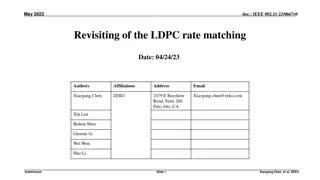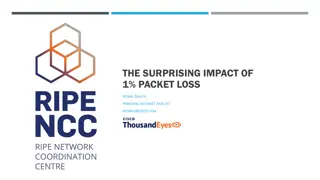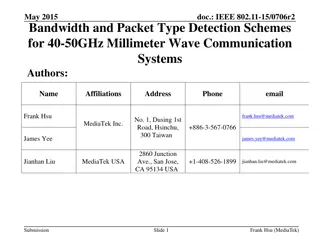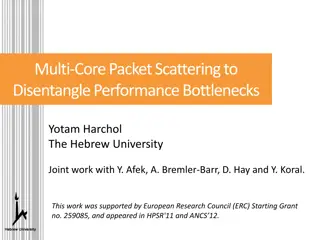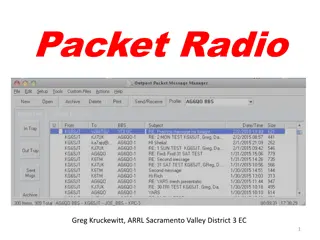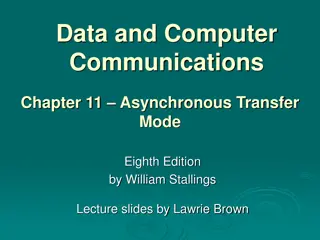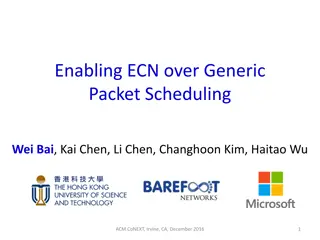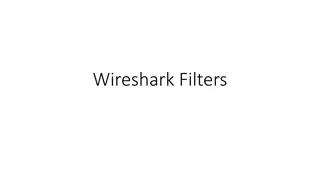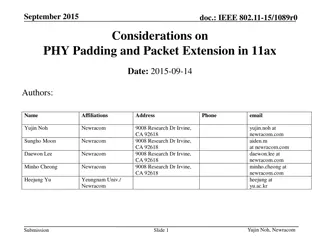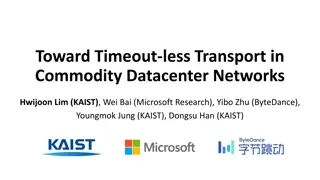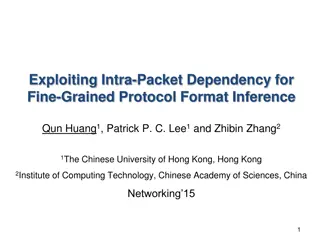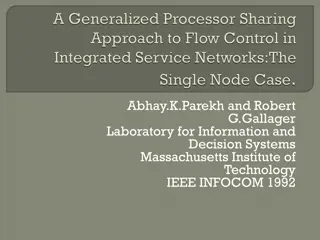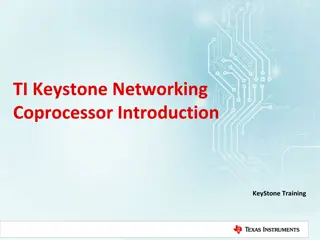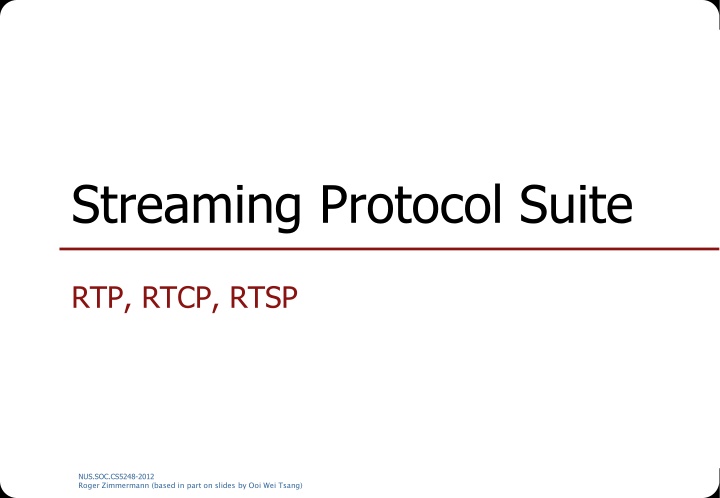
Streaming Protocol Suite for Multimedia Delivery
Explore the Streaming Protocol Suite encompassing RTP, RTCP, and RTSP, along with insights on HTTP streaming using DASH for on-demand video delivery. Learn about the key concepts, advantages, and limitations of these protocols in multimedia streaming applications.
Download Presentation

Please find below an Image/Link to download the presentation.
The content on the website is provided AS IS for your information and personal use only. It may not be sold, licensed, or shared on other websites without obtaining consent from the author. If you encounter any issues during the download, it is possible that the publisher has removed the file from their server.
You are allowed to download the files provided on this website for personal or commercial use, subject to the condition that they are used lawfully. All files are the property of their respective owners.
The content on the website is provided AS IS for your information and personal use only. It may not be sold, licensed, or shared on other websites without obtaining consent from the author.
E N D
Presentation Transcript
Streaming Protocol Suite RTP, RTCP, RTSP NUS.SOC.CS5248-2012 Roger Zimmermann (based in part on slides by Ooi Wei Tsang)
Notes on HTTP Streaming (1) On-Demand video streaming increasingly uses HTTP streaming DASH: Dynamic Adaptive Streaming over HTTP ISO/IEC Standard: Information technology MPEG systems technologies Part 6: Dynamic adaptive streaming over HTTP (DASH) JTC 1/SC 29; FCD 23001-6 NUS.SOC.CS5248-2012 Roger Zimmermann
Notes on HTTP Streaming (2) DASH has a number of advantages Server is simple, i.e., regular web server No firewall problems (use port 80 for HTTP) Standard (image) web caching works However, DASH does not Provide low latency for interactive, two-way applications (e.g., video conferencing) NUS.SOC.CS5248-2012 Roger Zimmermann (based in part on slides by Ooi Wei Tsang)
Streaming Protocol Suite (1) RTP: Real-Time Transport Protocol RTCP: RTP Control Protocol Published in 1996 as RFC 1889, and superseded by RFC 3550 in 2003 UDP, binary Transmission direction: RTP: from server to client (receiver) RTCP: either way (SR, RR) NUS.SOC.CS5248-2012 Roger Zimmermann (based in part on slides by Ooi Wei Tsang)
Streaming Protocol Suite (2) RTSP: Real-Time Streaming Protocol Published as RFC 2326 in 1998 TCP, text Transmission direction: Initiation from client, response by server VCR -type commands: PLAY, PAUSE, RECORD, TEARDOWN, Session initiation: DESCRIBE, SETUP NUS.SOC.CS5248-2012 Roger Zimmermann (based in part on slides by Ooi Wei Tsang)
RTCP Real-Time Transport Control Protocol NUS.SOC.CS5248-2012 Roger Zimmermann (based in part on slides by Ooi Wei Tsang)
RTCP Real-Time Control Protocol Provides receiver s feedback network conditions time synchronization receiver s description NUS.SOC.CS5248-2012 Roger Zimmermann (based in part on slides by Ooi Wei Tsang)
RTCP Packet Types Sender s Report (SR) Receiver s Report (RR) Source Description (SDES) Application Specific (APP) BYE NUS.SOC.CS5248-2012 Roger Zimmermann (based in part on slides by Ooi Wei Tsang)
Fields in SR NTP and RTP Timestamp relate media timestamp to real time Sender s stats byte count, packet count NUS.SOC.CS5248-2012 Roger Zimmermann (based in part on slides by Ooi Wei Tsang)
Fields in SR + RR Reception Report Number of lost packets % of lost packets Inter-arrival jitter Timestamp of last SR Delay since last SR SR tlsr tdlsr RR NUS.SOC.CS5248-2012 Roger Zimmermann (based in part on slides by Ooi Wei Tsang)
Deducing Network Conditions Packet Loss Rate Interarrival Jitter Round Trip Time NUS.SOC.CS5248-2012 Roger Zimmermann (based in part on slides by Ooi Wei Tsang)
Calculating Packet Loss Ratio (1) For each source, keep first sequence number S0 last sequence number Slast Expected packets = Slast S0 + 1 Count how many received packets NUS.SOC.CS5248-2012 Roger Zimmermann (based in part on slides by Ooi Wei Tsang)
Calculating Packet Loss Ratio (2) Example: S0 = 53,466 Slast = 1,349 Expected packets Ce = Slast S0 + 1 = Received packets Cr = 13,150 Packet loss rate: 1 - Cr/Ce = NUS.SOC.CS5248-2012 Roger Zimmermann (based in part on slides by Ooi Wei Tsang)
Calculating Interarrival Jitter Variance in packet spacing Define: Pi.arrival_time Pi.media_timestamp Pi.transit_time NUS.SOC.CS5248-2012 Roger Zimmermann (based in part on slides by Ooi Wei Tsang)
Calculating Interarrival Jitter Pi.transit_time = Pi.arrival_time - Pi.media_timestamp Difference in transit time for two consecutive packets = D(i,i-1) = |Pi.transit_time Pi-1.transit_time| NUS.SOC.CS5248-2012 Roger Zimmermann (based in part on slides by Ooi Wei Tsang)
Calculating Interarrival Jitter Jitter after packet i = Ji (i.e., this is a continuously updated value) Ji = (1-a) Ji-1 + a |D(i,i-1)| a: weight of most recent value vs. history RFC 1889: Ji = Ji-1 + ( |D(i,i-1)| Ji-1)/16 NUS.SOC.CS5248-2012 Roger Zimmermann (based in part on slides by Ooi Wei Tsang)
Calculating RTT (2) RTT: 6.125 s 5.250 s = 0.875 s NUS.SOC.CS5248-2012 Roger Zimmermann (based in part on slides by Ooi Wei Tsang)
RTCP Scaling (1) RTCP session reports should scale from a few to thousands of participants Constant rate control traffic: linear growth with the number of participants Recommendation: limit RTCP traffic to 5% of bandwidth; limit RR to 1.25% Vary report timing with random factor [0.5, 1.5] to calculated value t NUS.SOC.CS5248-2012 Roger Zimmermann (based in part on slides by Ooi Wei Tsang)
RTCP Scaling (2) B: Fix RTCP bandwidth N: Number of participants S: Mean RTCP packet size Sending interval = NUS.SOC.CS5248-2012 Roger Zimmermann (based in part on slides by Ooi Wei Tsang)
RTP Real-Time Transport Protocol NUS.SOC.CS5248-2012 Roger Zimmermann (based in part on slides by Ooi Wei Tsang)
RTP Packet Format RTP Payload Header RTP Header RTP Payload NUS.SOC.CS5248-2012 Roger Zimmermann (based in part on slides by Ooi Wei Tsang)
RTP Header 9 bits: protocol version, alignment, header extension, CSRC length, marker NUS.SOC.CS5248-2012 Roger Zimmermann (based in part on slides by Ooi Wei Tsang)
RTP Header Payload type: 7 bits Identify content E.g. 14: mp3; 32: MPEG-1 NUS.SOC.CS5248-2012 Roger Zimmermann (based in part on slides by Ooi Wei Tsang)
RTP Header Sequence number: 16 bits Packet sequence number NUS.SOC.CS5248-2012 Roger Zimmermann (based in part on slides by Ooi Wei Tsang)
RTP Header Media timestamp: 32 bits The instant when the first byte in this packet was captured 90 kHz timestamp (90,000 = 1 second) NUS.SOC.CS5248-2012 Roger Zimmermann (based in part on slides by Ooi Wei Tsang)
RTP Header SSRC: 32 bits Random, unique in a session Identifies a source (not host!) NUS.SOC.CS5248-2012 Roger Zimmermann (based in part on slides by Ooi Wei Tsang)
RTP Header Marker bit: Depends on payload E.g. beginning of frame NUS.SOC.CS5248-2012 Roger Zimmermann (based in part on slides by Ooi Wei Tsang)
On Receiving RTP packet Check SSRC New source? Existing source? which one? Check payload type Has format been changed? Which decoder should I use? NUS.SOC.CS5248-2012 Roger Zimmermann (based in part on slides by Ooi Wei Tsang)
RTSP Real-Time Streaming Protocol NUS.SOC.CS5248-2012 Roger Zimmermann (based in part on slides by Ooi Wei Tsang)
RTSP (1) Application-level protocol for establishing and controlling media sessions with real-time properties between end points control Simple, text-based Published in RFC 2326 (1998) Uses TCP Standard port: 554 NUS.SOC.CS5248-2012 Roger Zimmermann (based in part on slides by Ooi Wei Tsang)
RTSP (2) Allows VCR-type commands: DESCRIBE, SETUP, PLAY, TEARDOWN, PAUSE, RECORD, OPTIONS On next slides: Black text server command Blue text client response NUS.SOC.CS5248-2012 Roger Zimmermann (based in part on slides by Ooi Wei Tsang)
RTSP Example DESCRIBE rtsp://genesis/hackers.mov RTSP/1.0 RTSP/1.0 200 OK Server: QTSS/v96 Cseq: Content-Type: application/sdp Content-Base: rtsp://genesis/hackers.mov/ Content-length: 179 v=0 s=hackers.mov u=http://genesis.usc.edu/ e=admin@genesis.usc.edu c=IN IP4 128.125.163.19 a=control:/ a=range:npt=0-3714.90167 m=audio 0 RTP/AVP 10 a=control:trackID=2 NUS.SOC.CS5248-2012 Roger Zimmermann (based in part on slides by Ooi Wei Tsang)
RTSP Example SETUP rtsp://genesis/hackers.mov Transport: RTP/AVP;unicast;client_port=3000-3001 RTSP/1.0 200 OK Server: QTSS/v96 Cseq: Session: 4862038713701816342;timeout=6000 Transport: rtp/avp;server_port=2000-2001;client_port=3000-3001 PLAY rtsp://genesis/hackers.mov Session: 4862038713701816342 RTSP/1.0 200 OK Server: QTSS/v96 Cseq: Session: 4862038713701816342 RTP-Info:url=hackers.mov;seq=59970;ssrc=477987946;rtptime=263102960 NUS.SOC.CS5248-2012 Roger Zimmermann (based in part on slides by Ooi Wei Tsang)
RTSP Example [Session plays] TEARDOWN rtsp://genesis/hackers.mov Session: 4862038713701816342 RTSP/1.0 200 OK Server: QTSS/v96 Cseq: Session: 4862038713701816342 Connection: Close NUS.SOC.CS5248-2012 Roger Zimmermann (based in part on slides by Ooi Wei Tsang)
SIP Session Initiation Protocol NUS.SOC.CS5248-2012 Roger Zimmermann (based in part on slides by Ooi Wei Tsang)
SIP Application-layer control (signaling) protocol for creating, modifying, and terminating sessions with one or more participants. Text-based RFC 3261 Has been accepted as a standard for VoIP (Note: Skype does not use SIP) NUS.SOC.CS5248-2012 Roger Zimmermann (based in part on slides by Ooi Wei Tsang)
Application-Level Framing Expose details to applications Let application decide what to do with a packet, not transport protocol NUS.SOC.CS5248-2012 Roger Zimmermann (based in part on slides by Ooi Wei Tsang)
MPEG + RTP Application-Level Framing NUS.SOC.CS5248-2012 Roger Zimmermann (based in part on slides by Ooi Wei Tsang)
Previously, in CS5248 MPEG Compression Sequence, GOP, Picture, Slice, Macroblock, Block, DC/AC Coefficient I-Frame, P-Frame, B-Frame NUS.SOC.CS5248-2012 Roger Zimmermann (based in part on slides by Ooi Wei Tsang)
MPEG Frame Sizes Constant Bitrate (CBR) vs. Variable Bitrate (VBR) NUS.SOC.CS5248-2012 Roger Zimmermann (based in part on slides by Ooi Wei Tsang)
Previously, on CS5248 RTP headers SSRC, Media Timestamp, Marker Bit, Payload Type .. Application-Level Framing NUS.SOC.CS5248-2012 Roger Zimmermann (based in part on slides by Ooi Wei Tsang)
You are Here Encoder Decoder Middlebox Receiver Sender Network NUS.SOC.CS5248-2012 Roger Zimmermann (based in part on slides by Ooi Wei Tsang)
Application-Level Framing NUS.SOC.CS5248-2012 Roger Zimmermann (based in part on slides by Ooi Wei Tsang)
How to send/recv? Let the application decide, not the protocol stack. Tennenhouse + Clark NUS.SOC.CS5248-2012 Roger Zimmermann (based in part on slides by Ooi Wei Tsang)
Application Knows Best How to reorder packets Whether to ignore loss Which packet to retransmit NUS.SOC.CS5248-2012 Roger Zimmermann (based in part on slides by Ooi Wei Tsang)
Application Data Unit (ADU) Can be processed individually, even out-of- order Unit of error-recovery If part of an ADU is lost, the whole ADU is considered lost 8-Bit PCM audio: 1 ADU = 1 Byte MPEG1 Video: 1 ADU = NUS.SOC.CS5248-2012 Roger Zimmermann (based in part on slides by Ooi Wei Tsang)
How to chop data into packets? Every received packet should be useful (even in very lossy environments) Ideally, 1 ADU in 1 packet NUS.SOC.CS5248-2012 Roger Zimmermann (based in part on slides by Ooi Wei Tsang)
RTP Payload Header 12 bytes 4-12 bytes Rest of IP packet RTP Payload Header RTP Header RTP Payload MPEG Video-specific Header (32 bits) MPEG-1? 2? Temporal Reference I? P? B? Begin of Slice? End of Slice? NUS.SOC.CS5248-2012 Roger Zimmermann (based in part on slides by Ooi Wei Tsang)
RTP Header (Summary) 4 bytes 4 bytes 4 bytes Ver: version, P: padding, X: extension, CC: CSRC count, M: marker, PT: payload type, sequence number, media timestamp, SSRC NUS.SOC.CS5248-2012 Roger Zimmermann (based in part on slides by Ooi Wei Tsang)
MPEG Video-specific Header MBZ (5 bits) Unused. Must be 0. NUS.SOC.CS5248-2012 Roger Zimmermann (based in part on slides by Ooi Wei Tsang)

